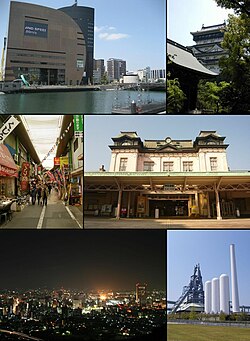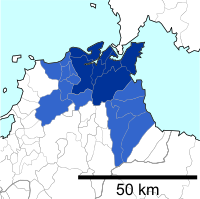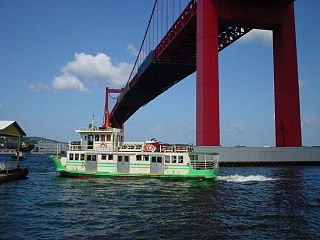Kitakyushu
Designated city in Kyushu, Japan From Wikipedia, the free encyclopedia
Designated city in Kyushu, Japan From Wikipedia, the free encyclopedia
Kitakyushu (Japanese: 北九州市, Hepburn: Kitakyūshū-shi) is a city located in Fukuoka Prefecture, Japan. As of June 1, 2019, Kitakyushu has an estimated population of 940,978, making it the second-largest city in both Fukuoka Prefecture and the island of Kyushu after the city of Fukuoka. It is one of Japan's 20 designated cities, one of three on Kyushu, and is divided into seven wards.
You can help expand this article with text translated from the corresponding article in Japanese. (December 2016) Click [show] for important translation instructions.
|
Kitakyushu
北九州市 | |
|---|---|
| City of Kitakyushu[1] | |
 Clockwise from top left: the Riverwalk shopping center; Kokura Castle; Mojiko Station; the former Higashida blast furnace; a night view of Kokura from Mount Adachi; and the Tanga Market in Kokura | |
 Location of Kitakyushu in Fukuoka Prefecture | |
 | |
| Coordinates: 33°53′N 130°53′E | |
| Country | Japan |
| Region | Kyushu |
| Prefecture | Fukuoka Prefecture |
| Government | |
| • Mayor | Kazuhisa Takeuchi |
| Area | |
| • Total | 491.95 km2 (189.94 sq mi) |
| Population (June 1, 2019) | |
| • Total | 940,978 |
| • Density | 1,900/km2 (5,000/sq mi) |
| Time zone | UTC+09:00 (JST) |
| City hall address | 1-1 Jōnai, Kokura Kita-ku, Kitakyushu-shi, Fukuoka-ken 803-8501 |
| Climate | Cfa |
| Website | www |
| Symbols | |
| Flower | Tsutsuji (Azalea) Himawari (Sunflower) |
| Tree | Ichiigashi (Japanese beech) |
Kitakyushu was formed in 1963 from a merger of municipalities centered on the historic city of Kokura, and its name literally means "North Kyushu City" in Japanese. It is located at the northernmost point of Kyushu on the Kanmon Straits, separating the island from Honshu, across from the city of Shimonoseki. Kitakyushu and Shimonoseki are connected by numerous transport links including the Kanmon Bridge and the Kanmon Tunnels (Roadway, Railway, and Shin-Kanmon). Kitakyushu's Urban Employment Area forms part of the Fukuoka-Kitakyushu Greater Metropolitan Region, which, with a population of 5,738,977 (2005-2006), is the largest metropolitan area in Japan west of the Keihanshin region.
Kokura Prefecture was founded separately from Fukuoka Prefecture in 1871 when the clan system was abolished. The old wooden-built Kokura Prefectural Office is still standing and is being restored. It is opposite Riverwalk Kitakyūshū. In 1876, Kokura Prefecture was absorbed by Fukuoka Prefecture. The city of Kokura was founded in 1900.
Yahata in Kitakyushu was the target for the beginning of the US bombing raids on the home islands on June 16, 1944, when 75 Boeing B-29 Superfortresses flew out from mainland China.[2]
Kokura was the primary target of the nuclear weapon "Fat Man" on August 9, 1945. Major Charles Sweeney had orders to drop the bomb visually. All three attempts failed due to clouds and smoke from Yahata, which is only 7 km (4.3 mi) west of Kokura and had air raids on the previous day, preventing him from identifying the target clearly. Additionally, a smoke screen was created by industrial workers burning barrels of coal tar and/or electric plant workers releasing steam.[3][4] The bomb was ultimately dropped on the city of Nagasaki, the secondary target, at 11:02 JST.
The city of Kitakyushu was founded on February 10, 1963, and was designated on April 1, 1963, by government ordinance. The city was born from the merger of five municipalities (Moji, Kokura, Tobata, Yahata and Wakamatsu) centered around the ancient feudal city of Kokura. The city's symbol mark is a flower with the character "north" (北, kita) in the middle and five petals representing the towns that merged.
As of 1 October 2018[update], the city had an estimated population of 945,595 and a total area of 491.95 km2 (189.94 sq mi).[5] The average population density is 1,922 persons /km2 (4,980/sq mi). It is now the country's 15th most populated city.[5] It has a much larger total area than that of Fukuoka which is only 343.39 km2 (132.58 sq mi).[5]
Kitakyushu has seven wards (ku):
| Wards of Kitakyushu | |||||
|---|---|---|---|---|---|
| Place Name | Map of Kitakyushu | ||||
| Rōmaji | Kanji | Color | Land area in km2 | ||
| 1 | Kokurakita-ku (administrative center) |
小倉北区 | 39.27 | ||
| 2 | Kokuraminami-ku | 小倉南区 | 170.25 | ||
| 3 | Moji-ku | 門司区 | 73.37 | ||
| 4 | Tobata-ku | 戸畑区 | 16.66 | ||
| 5 | Yahatahigashi-ku | 八幡東区 | 36.36 | ||
| 6 | Yahatanishi-ku | 八幡西区 | 83.04 | ||
| 7 | Wakamatsu-ku | 若松区 | 67.86 | ||
The city of Nakama, Fukuoka was to become the eighth ward of Kitakyushu in 2005 (to be called Nakama-ku). However, the merger was rejected on December 24, 2004 by Nakama's city council, despite having been initiated by Nakama City.
| Climate data for Yahatañishi-ku, Kitakyushu (1991−2020 normals, extremes 1977−present) | |||||||||||||
|---|---|---|---|---|---|---|---|---|---|---|---|---|---|
| Month | Jan | Feb | Mar | Apr | May | Jun | Jul | Aug | Sep | Oct | Nov | Dec | Year |
| Record high °C (°F) | 19.0 (66.2) |
24.0 (75.2) |
25.2 (77.4) |
30.1 (86.2) |
32.4 (90.3) |
34.2 (93.6) |
36.9 (98.4) |
36.7 (98.1) |
36.0 (96.8) |
33.0 (91.4) |
26.8 (80.2) |
24.8 (76.6) |
36.9 (98.4) |
| Mean daily maximum °C (°F) | 9.8 (49.6) |
10.9 (51.6) |
14.4 (57.9) |
19.6 (67.3) |
24.2 (75.6) |
27.0 (80.6) |
30.7 (87.3) |
31.9 (89.4) |
28.1 (82.6) |
23.2 (73.8) |
17.7 (63.9) |
12.2 (54.0) |
20.8 (69.5) |
| Daily mean °C (°F) | 6.2 (43.2) |
6.9 (44.4) |
10.0 (50.0) |
14.7 (58.5) |
19.3 (66.7) |
22.7 (72.9) |
26.8 (80.2) |
27.8 (82.0) |
24.0 (75.2) |
18.8 (65.8) |
13.3 (55.9) |
8.3 (46.9) |
16.6 (61.8) |
| Mean daily minimum °C (°F) | 2.8 (37.0) |
3.2 (37.8) |
5.9 (42.6) |
10.2 (50.4) |
14.9 (58.8) |
19.3 (66.7) |
23.7 (74.7) |
24.6 (76.3) |
20.6 (69.1) |
14.8 (58.6) |
9.3 (48.7) |
4.7 (40.5) |
12.8 (55.1) |
| Record low °C (°F) | −4.6 (23.7) |
−6.2 (20.8) |
−3.8 (25.2) |
0.5 (32.9) |
6.4 (43.5) |
10.5 (50.9) |
15.4 (59.7) |
17.6 (63.7) |
8.9 (48.0) |
3.5 (38.3) |
0.7 (33.3) |
−3.6 (25.5) |
−6.2 (20.8) |
| Average precipitation mm (inches) | 87.9 (3.46) |
79.2 (3.12) |
114.2 (4.50) |
125.4 (4.94) |
142.9 (5.63) |
239.5 (9.43) |
314.6 (12.39) |
198.1 (7.80) |
165.9 (6.53) |
85.2 (3.35) |
91.8 (3.61) |
75.9 (2.99) |
1,720.5 (67.74) |
| Average precipitation days (≥ 1.0 mm) | 10.8 | 10.4 | 10.9 | 10.0 | 9.0 | 12.3 | 11.8 | 10.0 | 9.7 | 7.3 | 9.4 | 9.8 | 121.4 |
| Mean monthly sunshine hours | 101.8 | 113.2 | 159.5 | 188.6 | 205.0 | 139.2 | 167.6 | 196.2 | 159.8 | 170.5 | 131.5 | 102.9 | 1,835.7 |
| Source: Japan Meteorological Agency[6][7] | |||||||||||||
This section needs additional citations for verification. (May 2009) |



Nippon Steel Corporation is a major employer, but the Yahata and Tobata plants are much reduced from their heyday of the 1960s. The Zenrin company known for its mapping and navigation software is based here[8] and so is Toto Ltd.[9] and Yaskawa Electric Corporation.[10] StarFlyer, an airline, is headquartered on the grounds of Kitakyushu Airport in Kokuraminami-ku, Kitakyūshū.[11] Previously the airline's headquarters were in the Shin Kokura Building (新小倉ビル, Shin-Kokura Biru) in Kokurakita-ku, Kitakyūshū.[12][13]
A smaller scale shopping center known as Cha Cha Town, next to the Sunatsu bus depot in Kokura Kita ward, was created by the Nishi-Nippon Railroad and bus company.
In 2009 Bridgestone Corporation opened a plant in Kitakyushu to produce large and ultralarge off-the-road radial tires for construction and mining vehicles.
The GDP in Greater Kitakyushu, Kitakyushu Metropolitan Employment Area was US$55.7 billion in 2010.[14][15]





Located at a strategic position on the south side of the Kanmon Straits, Kitakyushu is an important transport hub for traffic between Honshu and Kyushu and has a large port.
The Kitakyushu Airport opened on March 16, 2006. It is larger than the previous Kokura Airport and supports 24-hour operations thanks to its location on an artificial island in the Seto Inland Sea. It will eventually be connected with Kokura Station by a new fast rail link. A new airline based in the city called StarFlyer began operations when the airport opened.
Kokura Station, the city's central train station, is the penultimate stop on the JR West Sanyō Shinkansen before the Fukuoka terminus and all Shinkansen services stop here. It is served by local and express trains on JR Kyushu's Kagoshima and Nippō Main Lines. In the city, transport is provided the Kitakyushu Monorail and buses.
Mojikō Station in Moji-ku is the northern terminus of the Kagoshima Main Line, the most important line in the JR Kyushu network.
A tram network operated by the Nishi-Nippon Railroad known as the Kitakyushu Line once operated in the city; after dwindling passenger numbers in the 1970s the line was shut down in stages between 1980 and 2000. A railway using tram cars, the Chikuhō Electric Railroad, runs between Kurosaki-Ekimae and Chikuhō-Nōgata stations, serving Yahatanishi-ku and the neighboring city of Nōgata.
The metropolitan area of Kitakyushu is covered by the Kitakyushu Expressway, which has five routes serving the city, totaling 53 kilometers of four-lane expressways. Some of these expressways are elevated, especially around the city center. Route 1 serves the city center, while route 2 serves the port area. Route 3 is a short connector between routes 1 and 2, and route 4 is the longest of the Kitakyushu Expressway network, serving most of the city from north to south. Route 5 is a short link serving the inner port area.
In addition, Kitakyushu is bypassed by the Kyushu Expressway, the main north–south route on the island of Kyushu. The new Higashikyushu Expressway begins in Kitakyushu and runs along the eastern coast of Kyushu. North of Kitakyushu, the Kyushu Expressway crosses the six-lane Kanmonkyo Bridge and turns into the Chūgoku Expressway, the second longest in Japan, serving western Honshu.
There are several bridges in Kitakyushu and between the city and other places. The largest ones are the Kanmonkyo Bridge linking Kitakyushu and Shimonoseki (on Kyushu and Honshū respectively) via the Kanmon Straits and the Wakato Bridge linking the wards of Tobata and Wakamatsu. There are smaller bridges over the Onga River on the western border of the city.
On September 30, 2005, ownership of the Wakato Bridge was transferred from Japan Highway Public Corporation to Kitakyushu; on April 1, 2006, the bridge was transferred to the control of the Kitakyushu City Road Public Corporation.
Kitakyushu is the largest ferry port in Kyushu, Chūgoku, and Shikoku. Ferry services operate between Kitakyushu and Shimonoseki, Matsuyama, Tokushima, Kōbe, Ōsaka, Tokyo, Ulsan (Korea), Busan (Korea) and isolated islands in the city limits. The main ferry port is at Shin-Moji, and there are ferries at Moji and near Kokura Station.
In the Kanmon-Kitakyushu area, there are three commuter lines: the Wakato Ferry, the Kanmon Straits Ferry, and the Kanmon Straits Liner.


The limestone outcroppings on Hiraodai are said to resemble grazing sheep, so the plateau, the highest in Kyushu at 400–600 meters, is also known as the Yogun Plain. Some of the limestone caverns are open to the public.[16] The area contains the Sugao and Nanae Waterfalls. Sugao is about 20 meters. Nanae means "seven stages".
This section needs additional citations for verification. (May 2012) |
The 1986 family movie Koneko Monogatari was filmed here. The English version of the film, which is the story of the friendship of a kitten and a pug dog, was released in America in 1989 as The Adventures of Milo and Otis.
The 1958 comedy Rickshaw Man is based on a local folk hero of Kokura called Muhomatsu or "Wild Pine" and has been called the Japanese "Desperado". He is celebrated in the Kokura Gion Yamagasa festival. Toshiro Mifune plays the taiko drum in this movie.
Kitakyushu is featured in the late 2012 Call of Duty: Black Ops II game developed by Treyarch and published by Activision as a DLC map called Magma. In the map the city has been abandoned due to a volcanic eruption, and parts of the city are completely covered in lava.
There are festivals (matsuri) held in the summer in the city, including the Tobata Gion Yamagasa festival in Tobata-ku, Kitakyūshū.
It has been designated as an intangible cultural asset of Fukuoka Prefecture. People spin highly decorated "battle floats" as they pull them through the streets.[17]
People carry yamagasa (tiered floats decorated with flags by day and lanterns by night) on their shoulders.
People pull yamagasa parade floats along the street.
All the Gion festivals date back about 400 years. They were instituted to celebrate surviving an epidemic.[18]
This port-city festival involves colorfully costumed people pulling floats through the streets.[19]
This port-city festival celebrates fire, drums, and kappa (mythical amphibious creatures who love cucumbers).[20]
The Wasshoi Hyakuman Natsumatsuri brings all the festivals together for a grand parade and finale near City Hall in Kokura Kita ward. Kitakyushu was formed by the merging of Kokura, Yahata, Wakamatsu, Moji, and Tobata. As a result, the city began, on its tenth anniversary, to combine these local festivals into one. On the 25th anniversary, it was renamed Wasshoi Hyakuman because the city population had reached one million.
There are over 200 shops.[21]
The Center for Contemporary Art opened in May 1997 by former Japan Foundation chief curator Nobuo Nakamura and Akiko Miyake. The centre has shown works of internationally renowned artists such as Maurizio Cattelan and Anri Sala, and runs an internationally acclaimed studio programme for emerging artists.
Kitakyushu was selected as the host of the 2021 World Artistic Gymnastics Championships and the 2021 Rhythmic Gymnastics World Championships, both of which will take place in October 2021. The artistic gymnastics championship will take place in Kitakyushu City General Gymnasium, while the rhythmic competition will be contested in the West Japan Exhibition Centre.[22]

Kitakyushu is twinned with the following cities outside Japan.[23]
One city in Japan is twinned with Kitakyushu;

Seamless Wikipedia browsing. On steroids.
Every time you click a link to Wikipedia, Wiktionary or Wikiquote in your browser's search results, it will show the modern Wikiwand interface.
Wikiwand extension is a five stars, simple, with minimum permission required to keep your browsing private, safe and transparent.